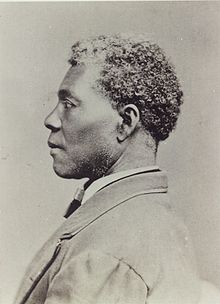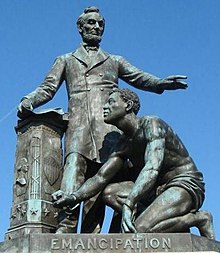| Archer Alexander | |
|---|---|
 | |
| Born | 1816 (1816) Lexington, Virginia, United States |
| Died | December 8, 1879(1879-12-08) (aged 62–63) St. Louis, Missouri, United States |
| Occupation | Model |
Archer Alexander (1816 – December 8, 1880) was a formerly enslaved American man who served as the model for the "emancipated slave" in the Emancipation Memorial 1876 located in Lincoln Park in Washington, D.C. He was the subject of an 1885 biography, The Story of Archer Alexander, from Slavery to Freedom, March 30, 1863 by William Greenleaf Eliot, published in 1885. Eliot's account of Alexander's life is partly historical fiction, as portions of the narrative were altered by his close friend Jesse Benton Fremont at the request of the publishers.
Early years
Alexander was born enslaved by the Alexander family near Lexington, Virginia, about 1816. He and his wife Louisa were brought to Dardenne Prairie, Missouri, in St. Charles County by his enslaver, James H. Alexander, in 1829. Louisa, formerly enslaved by Dr. Robert McCluer, was inherited by his daughter, Nancy McCluer, wife of James H. Alexander. James and Nancy Alexander had died by 1835, and their property and their enslaved were managed by their executor, William M. Campbell, providing the funds to care for their four orphaned children who had returned to Virginia to live with relatives. Besides working for Campbell, Archer Alexander was leased out as a carpenter, stonemason, and bricklayer. When James Alexander's children were grown, the property was dispersed; Archer, Louisa, and seven of their children were split up. Those seven were: Eliza (valued at $325), Mary Ann ($300), Archer ($225), James ($200), Alexander ($175), Lucinda ($150), and John ($125). Three of their children, Nellie, William, and Wesley, had already been sold by this time. Louisa became enslaved by James Naylor, a merchant, postmaster, and former Presbyterian elder living in Missouri on the Boone's Lick Road; Archer Alexander became enslaved by Richard H. Pitman, near Cottleville, Missouri.
American Civil War
During the American Civil War, Alexander overheard a meeting of local enslavers discussing a plot to sabotage a nearby railroad bridge using arms and ammunition they had stored in Captain James Campbell's icehouse. In February 1863, Alexander covertly notified a group of U.S. Army soldiers under the command of Lt. Col. Arnold Krekel that the Peruque Creek railroad bridge had been sabotaged by Confederate insurgents. Archer was shortly thereafter suspected of being the source of this information and fled the Pitman farm. He was captured by local slave catchers once but broke free. He continued on the Underground Railroad and found refuge in the home of William Greenleaf Eliot in St. Louis. There, he obtained employment in Eliot's house and was protected by a U.S. provost marshal. Pitman sent slave catchers to Eliot's home to kidnap and reenslave Alexander, putting Archer Alexander in the City Jail to be sold. Eliot rescued Alexander and contacted Pitman to purchase the man to emancipate him. However, on September 24, 1863, the St. Louis newspapers announced that Archer Alexander had been liberated by the Confiscation Act of 1862 because of his service to the U.S. military and Pitman's disloyalty to the United States. That fall, Alexander paid a German farmer to help Louisa and his daughters escape from Naylor and join him in St. Louis, where she was also granted emancipation. Eliot's biography of Alexander reports that in 1865, Louisa returned to Naylor's house for things she had left there. Alexander later learned that Louisa had died two days after her arrival of an unidentified cause. The location of her grave is unknown.
Emancipation Memorial

In 1865, Eliot was working with the Western Sanitary Commission to build a statue of Lincoln. The funding for an Emancipation Memorial featuring a statue of Lincoln had begun with a $5 donation from a formerly enslaved person, Charlotte Scott, from Virginia. All initial funds raised were donations from formerly enslaved people, U.S. Colored Troops (Union), and freedmen. They were held in trust for them by the Western Sanitary Commission, a St. Louis-based volunteer war relief agency. Thomas Ball made an acceptable model in 1865, but Eliot's group wanted a real freedman to pose for it. In 1869, Eliot gave Ball a photo of Alexander, and he was chosen as the model.
In 1876, the statue was unveiled, with many notable people in attendance, including President Ulysses S. Grant, members of his cabinet, Supreme Court justices, other government figures, and Frederick Douglass, another formerly enslaved person. However, neither Alexander nor Eliot was present.
Death and aftermath
Archer Alexander died in St. Louis, Missouri, on December 8, 1880. His funeral was held in his church, which was across from his home, Washington Metropolitan A.M.E. Zion Church. Alexander was buried in a common lot and unmarked grave at St. Peters U.C.C. Cemetery on Lucas and Hunt in Normandy, Missouri. The burial site was added to the Underground Railroad Network to Freedom in 2024.
According to DNA research, boxer Muhammad Ali was a great-great-great-grandson of Alexander.
Notes
- Johnson 1906, p. 74
- Neman, Daniel (February 15, 2024). "Three St. Louis-area sites added to Underground Railroad program". STLtoday.com. Retrieved February 15, 2024.
- Strauss 2018
References
- Eliot, William Greenleaf (1885). The Story of Archer Alexander: From Slavery to Freedom, March 30, 1863. Boston, Mass.: Cupples, Upham and Company: Old Corner Bookstore. Retrieved November 15, 2020 – via Documenting the American South (University of North Carolina at Chapel Hill).
- Griffith, Susan J. (2011). "Alexander, Archer (ca. 1810–1879)". The Online Encyclopedia of Significant People and Places in African American History. Retrieved October 5, 2013 – via BlackPast.org.
- Strauss, Ben (October 2, 2018). "DNA evidence links Muhammad Ali to heroic slave, family says". Washington Post.
- Keeven-Franke, Dorris. "Archer Alexander - the Untold Story of an American Hero".
- "Archer Alexander (d. December 8, 1880)". Encyclopedia Virginia.
- Alexander, Errol D. "Rattling of the Chains", a descendant and researcher-biographer of Archer Alexander.
- Christensen, Lawrence O. Dictionary of Missouri Biography. Columbia, MO: University of Missouri Press, 1999. ISBN 0-8262-1222-0
Attribution
- [REDACTED] This article incorporates text from a publication now in the public domain: Johnson, Rossiter, ed. (1906). "Alexander, Archer". The Biographical Dictionary of America. Vol. 1. Boston: American Biographical Society. p. 74.